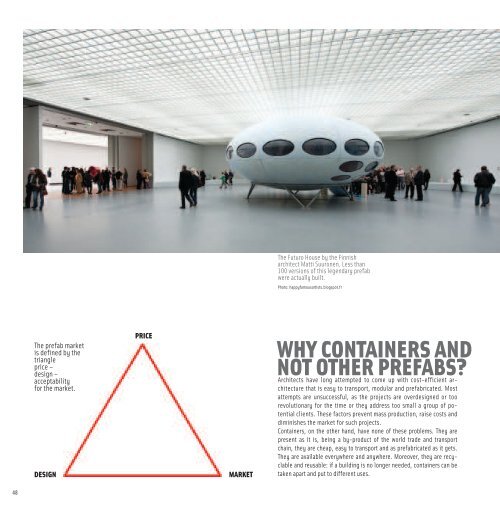pdf 1 - exhibitions international
pdf 1 - exhibitions international
pdf 1 - exhibitions international
You also want an ePaper? Increase the reach of your titles
YUMPU automatically turns print PDFs into web optimized ePapers that Google loves.
The prefab market<br />
is defined by the<br />
triangle<br />
price –<br />
design –<br />
acceptability<br />
for the market.<br />
DESIGN<br />
pRICE<br />
MARkET<br />
The Futuro House by the Finnish<br />
architect Matti Suuronen. Less than<br />
100 versions of this legendary prefab<br />
were actually built.<br />
Photo: happyfamousartists.blogspot.fr<br />
WHY CONTAINERS AND<br />
NOT OTHER pREfABS?<br />
Architects have long attempted to come up with cost-efficient architecture<br />
that is easy to transport, modular and prefabricated. Most<br />
attempts are unsuccessful, as the projects are overdesigned or too<br />
revolutionary for the time or they address too small a group of potential<br />
clients. These factors prevent mass production, raise costs and<br />
diminishes the market for such projects.<br />
Containers, on the other hand, have none of these problems. They are<br />
present as it is, being a by-product of the world trade and transport<br />
chain, they are cheap, easy to transport and as prefabricated as it gets.<br />
They are available everywhere and anywhere. Moreover, they are recyclable<br />
and reusable: if a building is no longer needed, containers can be<br />
taken apart and put to different uses.<br />
A NICHE OR IS<br />
THERE MORE?<br />
Container architecture has become an established<br />
branch of architecture, but is it a real<br />
alternative to other construction approaches or<br />
merely a niche that adds interest to the prefab<br />
market? The calculation is rather simple. The<br />
World Shipping Council has estimated that 29.2<br />
million TEU (20’ equivalent units) were in use in<br />
2011. This equals a total of 429.3 million square<br />
meters of container material. On the other end of<br />
the equation are the 2 billion square meters of<br />
new developments, which is roughly the annual<br />
growth rate of the construction market in China<br />
according to Prof. Wang Wei of the Shanghai<br />
Research Institute of Building Sciences. Even if<br />
all the world’s shipping containers (dry freight<br />
special and standard, tank, refrigerators) were<br />
pulled from the transport chain and converted<br />
into buildings, they could only service China’s<br />
construction market for a period of about 78<br />
days. There are therefore not enough containers<br />
available to significantly change trends in architecture.<br />
Even in the best case scenario with maximum<br />
utilization of existing containers, container<br />
architecture could never play a high-profile role<br />
on the global construction market. In certain<br />
niche areas, however, such as modular prefabricated<br />
buildings, temporary housing or event<br />
architecture, containers do present themselves<br />
as the best alternative.<br />
29,1 mio TEU in 2011<br />
All world’s shipping<br />
containers (dry<br />
freight<br />
special and standard,<br />
tank, refrigerators)<br />
could service China’s<br />
real-estate market<br />
for 78 days only.<br />
48 49<br />
weeks<br />
78 days










![01 -[BE/INT-2] 2 KOL +UITGEV+ - exhibitions international](https://img.yumpu.com/19621858/1/184x260/01-be-int-2-2-kol-uitgev-exhibitions-international.jpg?quality=85)






